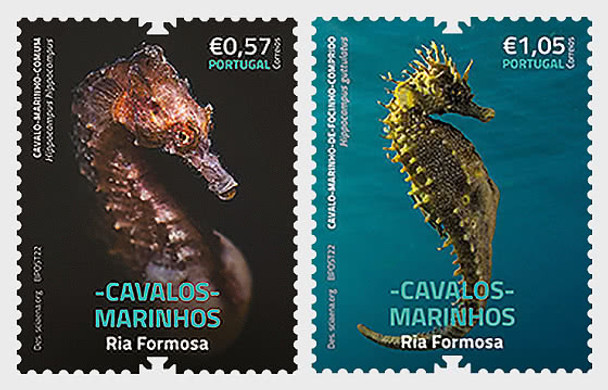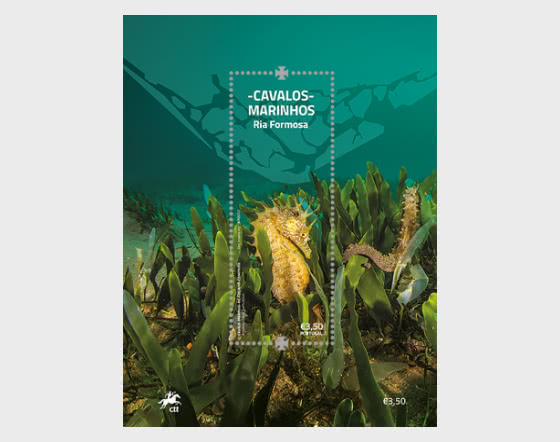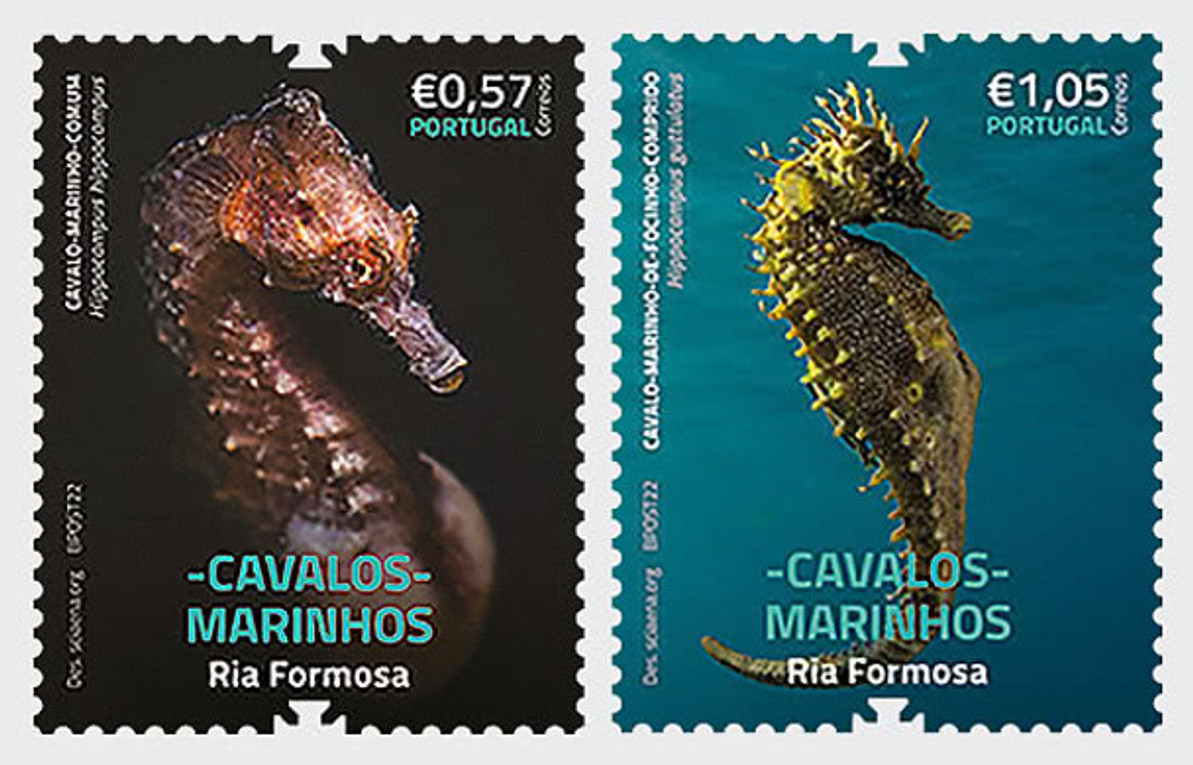STAMPS CALL ATTENTION TO SAVING THE PORTUGUESE SEAHORSES OF RIO FORMOSA

The ocean is inhabited by an infinite number of peculiar creatures that sometimes seem to be from another planet or even from the world of mythology. The seahorse, an enigmatic creature that has both intrigued and inspired humanity since its most distant past, is undoubtedly one of these.
Two species of seahorse can be found along the Portuguese coast: Hippocampus guttulatus and H. hippocampus. As elsewhere, they form part of the popular culture and identity of the coastal communities living nearby. This connection is particularly strong in the Algarve, especially around Ria Formosa, where, until recently, the world’s largest population of these two species could be found. Ria Formosa is a lagoon system that stretches 55 kilo- meters along the southern coast of Portugal, characterized by a string of islands and peninsulas that create a barrier to the waters of the Atlantic, and which creates a vast area of saltmarsh, channels and islets with calm waters. These natural characteristics make it a prime habitat for the seahorse and a haven of biodiversity. Countless marine species find protection and food in these waters, making Ria Formosa a unique ecosystem in the country and of internationally recognized importance.
Established as a Natural Park in 1987, this ecosystem has been under ever-increasing pressure from human activities in recent years, with its seagrass meadows, the essential habitat for the seahorse, disappearing at an alarming rate. Climate change, illegal beam trawling, excessive and unregulated anchoring of boats, and the spread of an invasive species of algae – Caulerpa prolifera – have all contributed to the disappearance of the once vast seagrass meadows, causing not only the decline of the seahorse and other species that depend on this habitat, but also decreasing the Ria Formosa’s capacity to sequester carbon.
In addition to these pressures, the seahorse has been the target of a new and very direct threat in recent years in the form of illegal capture for the Asian market. Whereas in the past these stunning animals were only collected in the Algarve when accidentally caught in fishing nets, global demand for the seahorses for use in traditional Chinese medicine has created a strong economic incentive for their illegal capture. Despite being protected by national and international legislation and being fished using methods not allowed in the Natural Park, the seahorse has thus become an easy and highly coveted target, contributing to the disappearance of a large part of its population.
But not all is lost. This problem was quickly identified by researchers, fishermen, decision-makers and others with an interest in Ria Formosa. Well-publicized seizures of large quantities of illegally caught seahorses brought the problem to the attention of the public. The threat hanging over one of the symbols of the Ria Formosa has thus triggered a new phase of awareness-raising and led various entities and people to contribute to safeguarding not only the seahorse, but the entire ecosystem surrounding it.
Efforts to combat the illegal fishing of seahorses must be ongoing and decisive. While measures already taken to date include permanent monitoring by researchers, increased enforcement by the relevant authorities and the creation of total protection zones in Ria Formosa, allowing the seahorse and other species that inhabit its waters to reproduce and thrive with minimal anthropogenic pressure, these measures must be further developed and complemented with others.
For Sciaena, a marine conservation organization based in the Algarve, the preservation of the seahorse and of the entire Ria Formosa is one of its greatest responsibilities and priorities. As such, it has contributed to the facilitation of communication between all entities responsible for Ria Formosa and raised awareness among all those who depend on the lagoon and enjoy the countless material or immaterial services it provides.
The seahorse of Ria Formosa poses an enormous challenge to the Algarve community in terms of uniting various institutions and people to safeguard this common asset for the collective benefit. It is only by meeting this challenge and countless similar challenges all around the world that we will be able to combat the devastating climate and biodiversity crises and secure the future of humanity.


Gonçalo Carvalho, Executive Coordinator of Sciaena
João Rodrigues, Marine Biologist and Conservation Photojournalist
(NatGeographic)
Miguel Correia, Expert on Syngnathidae for the International Union
for Conservation of Nature (IUCN)
Recent Posts
-
NEW AUSTRIA STAMP PROMOTES CONSERVATION & RECYCLING WITH POSTAL UNIFORMS!!
When a piece of clothing becomes a stamp: in the spirit of sustainability, used Austrian Post unifor …Jan 17th 2025 -
THIS NEW YEAR CHERUB PARTIED HIS WAY ONTO A US STAMP IN 2000!
The "New Year Cherub" is a popular motif often used in holiday decorations, greeting cards, and art. …Jan 3rd 2025 -
THE PARADE THAT MARCHED ITS WAY ONTO U.S. STAMPS
The Macy's Thanksgiving Day Parade is a beloved annual event held in New York City, first launched i …Nov 29th 2024




